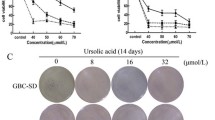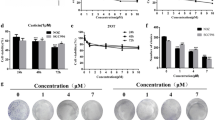Abstract
Purpose
In this work, we present a recently developed ruthenium complex that shows anticancer activity in gallbladder cancer cells.
Methods
After the synthesis of the new ruthenium complexes, the antiproliferative, cytotoxicity, and apoptosis activities were evaluated in vitro by the triple assay ApoTox-Glo. Then, the transcription levels of genes related to apoptosis were evaluated by real-time PCR (q-PCR).
Results
The ruthenium complex, called Ru-UCN3, inhibits the proliferation of gallbladder cancer cells G-415 by means of apoptosis, which was demonstrated by the overexpression of the pro-apoptotic genes Puma, Diablo, and Caspasa-9 together with the repression of the anti-apoptotic genes Bcl-xL and Bcl-2. In addition, we found strong caspase 3/7 activity in the cells at 24 h of the Ru-UCN3 exposure, which was evaluated by the triple ApoTox-Glo assay.
Conclusion
The new ruthenium complexes evaluated had an inhibitory effect on G-415 cells. We think that Ru-UCN3 could be a promising anticancer agent, which should be explored with more in vitro and in vivo assays and probably with the chemical modulation of this molecule.






Similar content being viewed by others
References
Olivares LV. Cancer of the gallbladder—Chilean statistics. Ecancermedicalscience. 2016;10:704. https://doi.org/10.3332/ecancer.2016.704.
DEIS. Departamento de Estadísticas e Información de Salud. 2018. http://www.deis.cl/defunciones-y-mortalidad-por-causas/. Accesed 27.11.18.
Sharma A, Sharma KL, Gupta A, Yadav A, Kumar A. Gallbladder cancer epidemiology, pathogenesis and molecular genetics: recent update. World J Gastroenterol. 2017;23(22):3978–98. https://doi.org/10.3748/wjg.v23.i22.3978.
Zaidi MY, Maithel SK. Updates on gallbladder cancer management. Curr Oncol Rep. 2018;20(2):21. https://doi.org/10.1007/s11912-018-0664-3.
Stinton LM, Shaffer EA. Epidemiology of gallbladder disease: cholelithiasis and cancer. Gut and Liver. 2012;6(2):172–87. https://doi.org/10.5009/gnl.2012.6.2.172.
Utsumi M, Aoki H, Kunitomo T, Mushiake Y, Yasuhara I, Arata T, et al. Evaluation of surgical treatment for incidental gallbladder carcinoma diagnosed during or after laparoscopic cholecystectomy: single center results. BMC Res Notes. 2017;10:56. https://doi.org/10.1186/s13104-017-2387-1.
Thongprasert S, Napapan S, Charoentum C, Moonprakan S. Phase II study of gemcitabine and cisplatin as first-line chemotherapy in inoperable biliary tract carcinoma. Ann Oncol. 2005;16:279–81. PMID: 15668284.
Thota S, Rodrigues DA, Crans DC, Barreiro EJ. Ru(II) compounds: next-generation anticancer metallotherapeutics? J Med Chem. 2018;61:5805–21. https://doi.org/10.1021/acs.jmedchem.7b01689.
Valle J, Wasan H, Palmer DH, Cunningham D, Anthoney A, Maraveyas A, et al. Cisplatin plus gemcitabine versus gemcitabine for biliary tract cancer. N Engl J Med. 2010;362(14):1273–81.
Kostova L. Ruthenium complex as anticancer agents. Curr Med Chem. 2006;13:1085–107. https://doi.org/10.2174/09298670677636094.
Klajner M, Licona C, Fetzer L, Hebraud P, Mellitzer G, Pfeffer M, et al. Subcellular localization and transport kinetics of ruthenium organometallic anticancer compounds in living cells: a dose-dependent role for amino acid and iron transporters. Inorg Chem. 2014;53(10):5150–8. https://doi.org/10.1021/ic500250e Epub 2014 May 1.
Kratz F, Keppler BK, Messori L, Smith C, Baker EN. Protein-binding properties of two antitumour Ru(III) complexes to human apotransferrin and apolactoferrin. Metal-Based Drugs. 1994;1(2–3):169–73. https://doi.org/10.1155/MBD.1994.169.
Śpiewak K, Brindell M. Impact of low- and high-molecular-mass components of human serum on NAMI-A binding to transferrin. J Biol Inorg Chem. 2015;20(4):695–703. https://doi.org/10.1007/s00775-015-1255-5.
Allardyce CS, Dyson PJ. Ruthenium in medicine current clinical uses and future prospects. Platin Met Rev. 2001;45(2):62–69.
Jaramillo P M, Hoyos SI. Carcinoma de vesícula biliar en el Hospital Pablo Tobón Uribe de Medellín. Revista Colombiana de Cirugía. (2009);24(4):250–257. Available from: http://www.scielo.org.co/scielo.php?script=sci_arttext&pid=S2011-75822009000400007&lng=en.
Zhu AX, Hong TS, Hezel AF, Kooby DA. Current management of gallbladder carcinoma. The oncologist. (2010);15(2):168–181. https://doi.org/10.1634/theoncologist.2009-0302.
Oun R, Moussa YE, Wheate NJ. The side effects of platinum-based chemotherapy drugs: a review for chemists. Dalton Trans. 2018;47:6645–53.
Ndagi U, Mhlongo N, Soliman ME. Metal complexes in cancer therapy—an update from drug design perspective. Drug Des Devel Ther. 2017;11:599–616. https://doi.org/10.2147/DDDT.S119488.
Ramírez-Rivera S, Pizarro S, Gallardo M, Gajardo F, Delgadillo A, De La Fuente-Ortega E, et al. Anticancer activity of two novel ruthenium compounds in gastric cancer cells. Life Sci. 2018;213:57–65.
Lai S-H, Jiang G-B, Yao J-H, Li W, Han B-J, Cheng Z, et al. Cytotoxic activity, DNA damage, cellular uptake, apoptosis and western blot analysis of ruthenium(II) polypyridyl complex against human lung adecarcinoma A549 cell. J Inorg Biochem. 2015;152:1–9.
Marta M, Elie BT, Pilar G, et al. Synthesis and anticancer activity of carbosilane metallodendrimers based on arene ruthenium(II) complexes. Dalton Trans. 2016;45:7049–66. https://doi.org/10.1039/C6DT00465B.
Hassan M, Watari H, AbuAlmaaty A, Ohba Y, Sakuragi N. Apoptosis and molecular targeting therapy in cancer. Biomed Res Int. 2014;2014:1–23. https://doi.org/10.1155/2014/150845.
Matsuura K, Canfield K, Feng W, Kurokawa M. Metabolic regulation of apoptosis in cancer. Int Rev Cell Mol Biol. 2016;327:43–87. https://doi.org/10.1016/bs.ircmb.2016.06.006.
Villota H, Pizarro S, Gajardo F, Delgadillo Á, Cortés-Mancera F, Bernal G. Selective cytotoxicity of a novel compound based on ruthenium II in a gallbladder carcinoma cell line. In: Torres I, Bustamante J, Sierra D, editors. VII Latin American Congress on Biomedical Engineering CLAIB 2016, Bucaramanga, Santander, Colombia, October 26th -28th, 2016. IFMBE proceedings, vol. 60. Singapore: Springer; 2017. https://doi.org/10.1007/978-981-10-4086-3_74.
Villota H, Pizarro S, Gajardo F, Delgadillo Á, Cortés-Mancera F, Bernal G. Apoptosis induced by a novel ruthenium II complex in a gallbladder carcinoma cell line. In: Torres I, Bustamante J, Sierra D, editors. VII Latin American congress on Biomedical Engineering CLAIB 2016, Bucaramanga, Santander, Colombia, October 26th -28th, 2016. IFMBE proceedings, vol. 60. Singapore: Springer; 2017. https://doi.org/10.1007/978-981-10-4086-3_75.
Lima AP, Pereira FC, Almeida MAP, Mello FMS, Pires WC, Pinto TM, et al. Cytoxicity and apoptotic mechanism of ruthenium(II) amino acid complexes in sarcoma-180 tumor cells. PLoS One. 2014;9(10):e105865. https://doi.org/10.1371/journal.pone.0105865.
Sharma G, Rana NK, Singh P, Dubey P, Pandey DS, & Koch B. p53 dependent apoptosis and cell cycle delay induced by heteroleptic complexes in human cervical cancer cells. Biomedicine & Pharmacotherapy. (2017);88:218–231. https://doi.org/10.1016/j.biopha.2017.01.044
de Lima AP, de Castro Pereira F, Tiago CAS, et al. Induction of Cell Cycle Arrest and Apoptosis by RutheniumComplex cis-(Dichloro)tetramineruthenium(III) Chloridein Human Lung Carcinoma Cells A549. Biol Trace Elem Res. 2012. https://doi.org/10.1007/s12011-011-9275-7.
Hoek J, Bloemendal KM, van der Velden LAA, van Diessen JNA, van Werkhoven E, Klop WMC, et al. Nefrotoxicidad como un factor limitante de la dosis en un régimen de quimiorradioterapia basada en cisplatino a dosis altas para los carcinomas de cabeza y cuello. Cánceres. 2016;8(2):21. https://doi.org/10.3390/cancers8020021.
Stone JB, DeAngelis LM. Neurotoxicidad inducida por el tratamiento del cáncer: un enfoque en tratamientos más nuevos. Comentarios de la naturaleza. Clin Oncol. 2016;13(2):92–105. https://doi.org/10.1038/nrclinonc.2015.152.
Funding
This study was funded by CORFO - Chile 14IDL2-30087.
Author information
Authors and Affiliations
Corresponding author
Ethics declarations
Conflict of Interest
The authors declare that they have no conflict of interest.
Additional information
Publisher’s Note
Springer Nature remains neutral with regard to jurisdictional claims in published maps and institutional affiliations.
Rights and permissions
About this article
Cite this article
Villota, H., Pizarro, S., Gajardo, F. et al. Ruthenium Complex Induce Cell Death in G-415 Gallbladder Cancer Cells. J Gastrointest Canc 51, 571–578 (2020). https://doi.org/10.1007/s12029-019-00278-x
Published:
Issue Date:
DOI: https://doi.org/10.1007/s12029-019-00278-x




